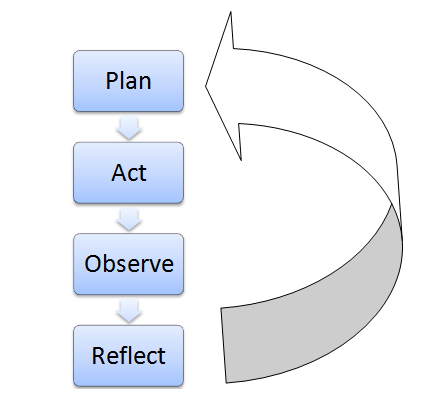Action Research
Action research can be defined as “an approach in which the action researcher and a client collaborate in the diagnosis of the problem and in the development of a solution based on the diagnosis”[1]. In other words, one of the main characteristic traits of action research relates to collaboration between researcher and member of organisation in order to solve organizational problems.
Action study assumes social world to be constantly changing, both, researcher and research being one part of that change.[2] Generally, action researches can be divided into three categories: positivist, interpretive and critical.
Positivist approach to action research, also known as ‘classical action research’ perceives research as a social experiment. Accordingly, action research is accepted as a method to test hypotheses in a real world environment.
Interpretive action research, also known as ‘contemporary action research’ perceives business reality as socially constructed and focuses on specifications of local and organisational factors when conducting the action research.
Critical action research is a specific type of action research that adopts critical approach towards business processes and aims for improvements.
The following features of action research need to be taken into account when considering its suitability for any given study:
- It is applied in order to improve specific practices. Action research is based on action, evaluation and critical analysis of practices based on collected data in order to introduce improvements in relevant practices.
- This type of research is facilitated by participation and collaboration of number of individuals with a common purpose
- Such a research focuses on specific situations and their context
Advantages of Action Research
- High level of practical relevance of the business research;
- Can be used with quantitative, as well as, qualitative data;
- Possibility to gain in-depth knowledge about the problem.
Disadvantages of Action Research
- Difficulties in distinguishing between action and research and ensure the application of both;
- Delays in completion of action research due to a wide range of reasons are not rare occurrences
- Lack of repeatability and rigour
It is important to make a clear distinction between action research and consulting. Specifically, action research is greater than consulting in a way that action research includes both action and research, whereas business activities of consulting are limited action without the research.
Action Research Spiral
Action study is a participatory study consisting of spiral of following self-reflective cycles:
- Planning in order to initiate change
- Implementing the change (acting) and observing the process of implementation and consequences
- Reflecting on processes of change and re-planning
- Acting and observing
- Reflecting
Action Research Spiral
Kemmis and McTaggart (2000) do acknowledge that individual stages specified in Action Research Spiral model may overlap, and initial plan developed for the research may become obselete in short duration of time due to a range of factors.
The main advantage of Action Research Spiral model relates to the opportunity of analysing the phenomenon in a greater depth each time, consequently resulting in grater level of understanding of the problem.
Disadvantages of Action Research Spiral model include its assumption each process takes long time to be completed which may not always be the case.
My e-book, The Ultimate Guide to Writing a Dissertation in Business Studies: a step by step assistance offers practical assistance to complete a dissertation with minimum or no stress. The e-book covers all stages of writing a dissertation starting from the selection to the research area to submitting the completed version of the work within the deadline.
References
[1] Bryman, A. & Bell, E. (2011) “Business Research Methods” 3rd edition, Oxford University Press
[2] Collis, J. & Hussey, R. (2003) “Business Research. A Practical Guide for Undergraduate and Graduate Students” 2nd edition, Palgrave Macmillan



